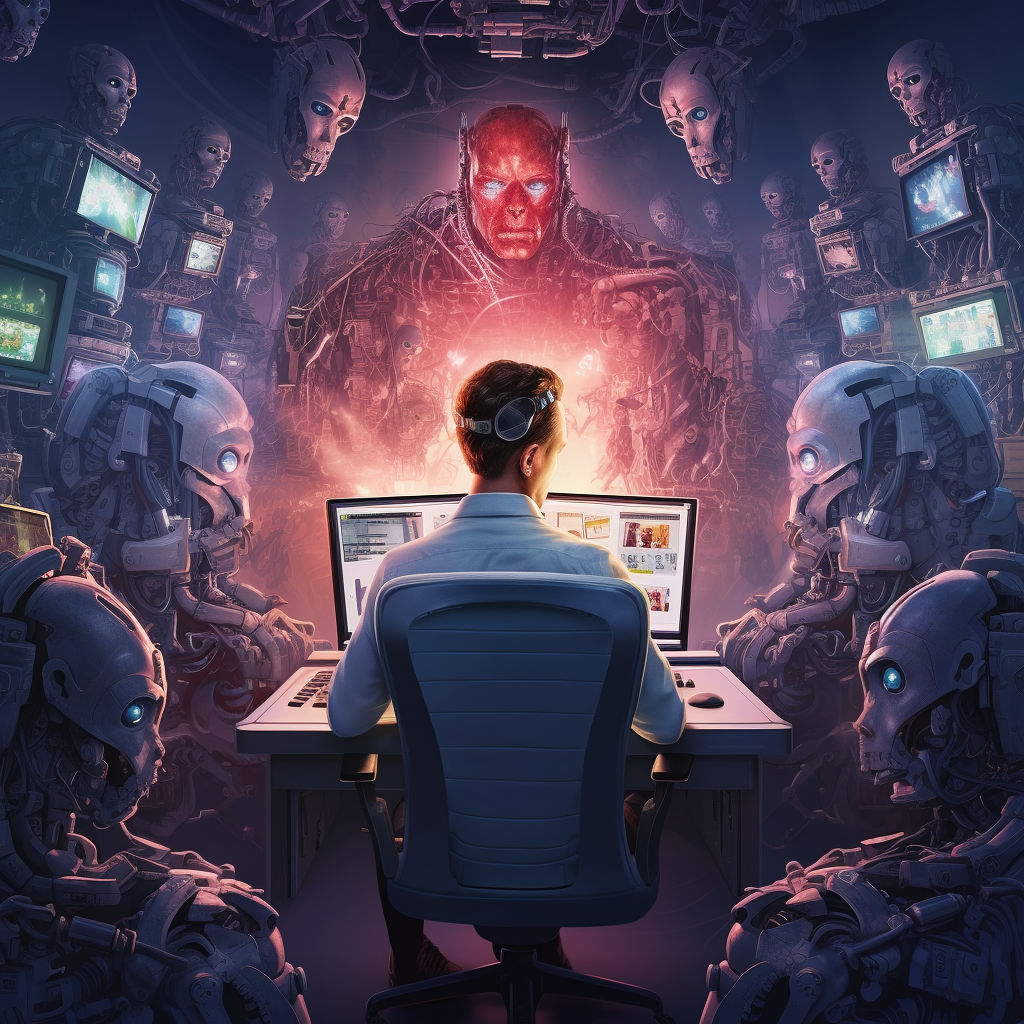2023 was an absolutely fascinating year for emerging technologies and our visions of what the future will shape into, especially and perhaps mainly due to chatgpt dominating headlines and bringing renewed interest in AI across the world. As we kick off 2024, it’s important to start thinking about some of the tech trends that might be shaping this year, and after going over numerous 2024 tech trend reports and articles, we’ve picked out the most interesting trends that are shaping our technological landscape this year, so you don’t have to.
We’re also highlighting a few groundbreaking technologies showcased at CES 2024 for those that missed the event. These not only resonate with our identified trends but also point us towards something we’ll be seeing significantly more of.
So, let’s get started and look into what’s unfolding right before us in 2024.
#7. Sustainable Technology

As global attention turns towards environmental concerns, sustainable technology is becoming increasingly important. This includes advancements in renewable energy sources, eco-friendly materials, and technologies that reduce carbon footprints, aiming to balance economic growth with environmental stewardship. This has been a significant trend for years now and it shows no sign of slowing down. Europe’s share of innovation funding going more towards this has been growing and we can already start to hear the rhetoric of sustainability, climate change etc being ramped up as we go into a massive election year, but more on this in a few points.
#6. Metaverse and Spatial Computing

The Metaverse represents a collective virtual shared space, created by the convergence of enhanced physical reality and digital realms. It’s a trend that’s redefining digital interaction, offering immersive experiences in entertainment, social networking, remote work, and education through technologies like VR, AR, and 3D environments. Though I don’t touch it in the CES part of this episode there were more headsets or goggles that enabled Augmented reality experiences that were displayed at CES. from the many conversations I’ve had on the podcast before, even with the less than stellar reception of Apple’s Vision Pro we can expect this year to continue the march towards a metaverse reality when the Vision Pro is finally publicly released on February 2nd. And as many are hoping , if this goes well it might start an snowball of renewed interest in the metaverse. I personally think we are still a few years away from this taking hold. But we’ll see over the next few months. https://www.forbes.com/sites/davidwalcott/2023/12/29/ai-has-won-2023-will-the-metaverse-win-2024/?sh=38a7d48c853c
#5. Quantum Computing
Quantum computing is set to revolutionize our approach to complex problem-solving. It holds the potential to perform calculations at unprecedented speeds, tackling challenges in areas like drug discovery, climate modeling, and cryptography that are currently beyond the reach of classical computers. While the siege on RSA encryption is underway, it is crucial to acknowledge that the encryption method itself is robust and has withstood more than 40 years of technological innovation. In 2024, transitioning to quantum-resistant cryptography will become a mainstream boardroom discussion. No longer a buzzword or a topic to be tabled, becoming crypto-agile to prepare for post-quantum encryption will be a key focus for the C-suite next year.
This shift has massively been supported by the US National Institute of Standards and Technology’s (NIST) development of quantum-resistant encryption and its impactful educational campaign on quantum’s threat to decryption. They have now transformed a once theoretical discussion about decryption into a mainstream business focus.
https://www.siliconrepublic.com/machines/quantum-computing-trends-2024-sectigo-tim-callan
#4. Crypto Winter

Amidst the volatility and regulatory challenges in the cryptocurrency market, this trend focuses on the transition and maturation of the crypto industry. It reflects a period of consolidation and potential disillusionment, but also an opportunity for long-term, sustainable growth in the digital currency and blockchain space.
With Binance’s CEO being convicted pleaded guilty to failing to maintain an effective anti-money laundering (AML) program, in violation of the BSA and has resigned as CEO of Binance, Sam bankman fried and the FTX scandal, and the disruptive potential of quantum computers that we just talked about many are calling for a decrease in interest and movement in the crypto space. However, others are waiting in anticipation of a bitcoin ETF in early 2024, and if successfully passed the crypto winter will quickly turn into a crypto moonlaunch, drawing interest, money, and of course memes back into this space.
#3. Phydigital Convergence
The fusion of physical and digital experiences through wearables and augmented reality technologies is reshaping how we interact with the world. This trend sees the rise of sophisticated wearables and AR/VR integrations that blend the physical and digital realms, enhancing everyday experiences from fitness to entertainment and work.
Meta, Google and Microsoft are all developing smart glasses that incorporate AI for the purpose of visual and voice answering. Already, Meta debuted experimental visual search for its Ray Ban smart glasses, which allow users to ask questions and get answers. OpenAI is reportedly in talks to add object-recognition to Snap’s Spectacles devices. Humane.ai developed a pin which is controlled with a combination of voice, a camera, gestures and a tiny built-in projector. (For those of you who watch Big Mouth on Netflix…yes, that brooch.)The next generation of wearables will be powered by multimodal AI systems, which can combine images and other forms of data with text, creating responses from multiple modes of presenting information.
This fits into some of the technologies that are interesting to mention from CES 2024.
#2. Digital Trust in a Year of Major Elections
In the coming year, there will be more than 70 elections, with around 4.2 billion people voting. That’s more than half the planet. It’s easier than ever to intentionally manipulate voters using misinformation created with high-quality synthetic contentIn the coming year, there will be more than 70 elections, with around 4.2 billion people voting. That’s more than half the planet. It’s easier than ever to intentionally manipulate voters using misinformation created with high-quality synthetic content In a year with significant global electoral activities, the emphasis on digital trust is paramount. This involves securing digital platforms against misinformation, protecting the integrity of online voting systems, and
https://techcrunch.com/2024/01/09/2648953/ maintaining public confidence in digital channels that are crucial for democratic processes.
As deepfakes proliferate, their ability to mislead and sow distrust is becoming of major concern to security experts — and the general public. A recent survey from McAfee found that the vast majority of Americans (84%) are worried about how deepfakes will be used in 2024, particularly where it concerns elections and addresses given by public figures.
Several solutions to the deepfakes problem have been proposed, from crypto watermarks to metadata — none perfect. But an increasing number of news organizations are coalescing around blockchain tech as a means of verifying that content came from a reliable source.
Fox became the latest example, announcing today that it partnered with Polygon Labs, a layer-2 blockchain focused on scaling Ethereum, to release an open source protocol for media companies to register their articles, photographs and more. Called Verify, Fox and Polygon are pitching the protocol as a means for outlets to protect their IP while letting consumers verify the authenticity of content.
“The Verify protocol establishes the origin and history of original journalism by cryptographically signing individual pieces of content on the blockchain,”
#1. Artificial Intelligence

Obviously the number one trend for this year will be the same as last year. AI. Especially with the possibility that Chatgpt 5.0 or Q* could be released publicly? Lots of interesting things to pay attention to this year but 2 to think about.
a. New materials connected to Deepmind’s discovery. DeepMind quietly released yet another tool in 2023, and this one could revolutionize material discovery. It’s a deep learning-based tool known as Graphical Networks for Material Exploration (GNoME), and it has already predicted the structures for 2.2 million novel materials. Impressively, more than 700 of these materials have already been synthesized in laboratories and are currently undergoing testing. To me this was really one of the first ideas that felt like we were approaching the technological singularity when I read about it.
b. Idea to fully developed product. This is less about prompt engineers and more of a collaborative activity with AI. I personally call it ‘looping’ when using chatgpt. Others call it “concept-to-concrete,” and you could say it was initially slightly described as the centaur teams that came out of chess. Essentially it is using AI to run through a series of ideas, constantly pull the best one out, and use that as your next step, all the while narrowing down the work towards a finished deliverable. Beyond just text we are getting closer to having AI in the full product loop for many different brands and products, and is certainly something any business leader should pay attention to as it could save time and resources once fully implemetned.
CES 2024. Interesting New Tech
A. X1 Interpreter Hub

A new real-time translator: The system works out of the box, without having to download a separate app. For in-person meetings, two devices are touched together to initiate conversation translation. The handheld devices house earbuds and is capable of supporting up to 20 people at once in five languages. https://techcrunch.com/2024/01/08/timekettles-699-translation-hardware-handles-multiple-languages-at-once/
B. Verify
Fox has partnered with Polygon Labs, a developer of scaling networks for Ethereum, to release an open source protocol — called Verify — for media companies to register their articles, photographs and more. Fox and Polygon are pitching the protocol as a means for outlets to protect their IP while letting consumers verify the authenticity of content. Learn more about the protocol.https://techcrunch.com/2024/01/09/2648953/
C. Celestron’s Origin

Celestron’s Origin takes remote commands from a connected mobile app and automatically locates objects. You can set it up and schedule it to take images of an object at a specific time so you can look at celestial wonders from the comfort of your living room or wake up to a whole batch of NASA-worthy images it captured while you were asleep. https://www.popsci.com/gear/best-gadgets-tech-ces-2024/
D. Swarovski Optik AX Vision
Binoculars that can identify wildlife using AI: Swarovski Optik AX Vision. They feel almost like a regular pair of binos with 10x magnification and a 32mm objective lens diameter. A third set of optics running up the middle, however, contains a digital sensor that can capture images and videos of wildlife as you observe it. Connect the AX Visio to Swarovski’s app to share images or get more information about the animals in the frame https://www.popsci.com/gear/best-gadgets-tech-ces-2024/
Conclusion

As we reflect on the tech trends of 2024, it’s evident that we’re not just witnessing technological advancements, but a transformative shift in how we interact with the world. From the rise of sustainable technology to the blending of physical and digital realms through wearables, each trend is reshaping our daily lives and work. The potential emergence of AI models like ChatGPT 5.0 or Q* is particularly exciting, as it could lead to even more revolutionary developments in AI, further blurring the lines between human and machine collaboration. The challenges and opportunities presented by these trends will require us to adapt, innovate, and think critically about the future we’re building. As we continue this journey, one thing is clear: the future is not just something we enter, but something we actively create. 2024 is set to be a pivotal year in this ongoing endeavor, bringing us closer to a world where technology not only enhances our capabilities but also enriches our human experience.










